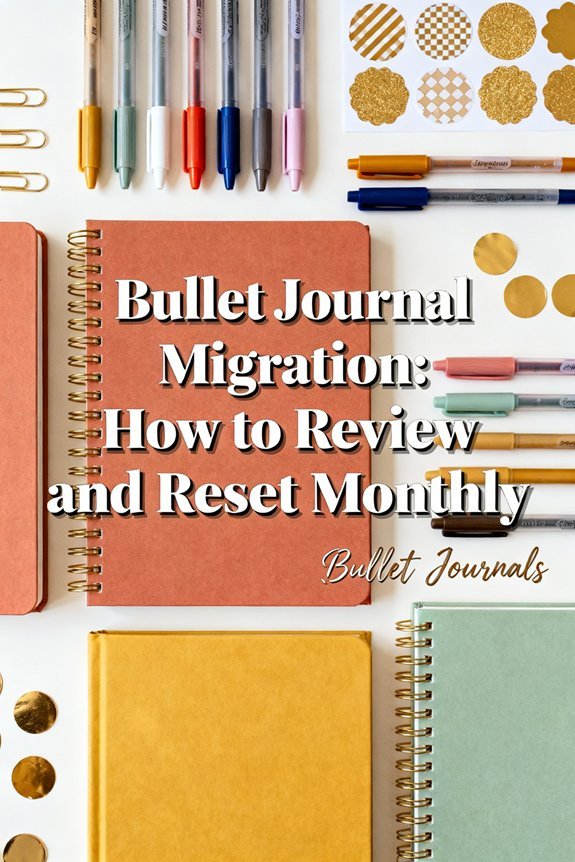Bullet journal migration is your monthly reset process where you review each unfinished task and decide its fate. At month's end, evaluate every incomplete item using four categories: migrate forward (mark with >), schedule later (mark with <), complete now (mark with X), or eliminate entirely (strike through). This filtering system converts scattered tasks into intentional priorities while revealing productivity patterns and recurring obstacles. You'll spot what's working, what you're avoiding, and where your energy actually flows. The migration process below shows you exactly how to make these decisions systematically.
Key Takeaways
- Migration transforms scattered tasks into an active system by reviewing each undone item to determine relevance for the upcoming month.
- Use specific symbols during review: X for completed, > for migrated, < for scheduled, and strike-through for eliminated tasks.
- Categorize incomplete tasks into relevant, needs completion, eliminate, or schedule later to create clarity and align with current priorities.
- Conduct migration at month-end as a non-negotiable calendar appointment, reviewing patterns to identify what's working versus what's being avoided.
- Treat repeatedly migrated tasks as data revealing obstacles, then eliminate unnecessary items or redesign systems to better serve current needs.
What Bullet Journal Migration Actually Means

Migration converts your scattered tasks into a living system. You're not just copying incomplete items forward—you're actively deciding what deserves your attention next month.
Here's how it works: Review each undone task from your current month. Ask yourself if it still matters. If yes, migrate it by marking it with an arrow and rewriting it in your new monthly log. If no, cross it out without guilt.
Migration forces the essential question: Does this task still deserve space in your life, or just in your guilt?
This process embodies bullet journal basics at their finest. You're filtering noise from signal, altering your journal from a static list into vibrant documentation of your evolving priorities.
The migration benefits are immediate. You'll spot patterns in what you consistently avoid, revealing misaligned commitments. You'll reduce mental clutter by consciously releasing outdated obligations.
Most importantly, you'll start each month with intentional focus rather than inherited chaos.
Migration isn't administrative busywork—it's strategic reflection disguised as organization. Combined with effective time management techniques, this monthly review ritual transforms planning from a chore into a tool for building a more meaningful and purposeful life.
Why Monthly Reviews Matter More Than Daily Logging
You'll spot meaningful patterns in your habits and productivity when you review a full month's worth of entries instead of isolated daily logs.
This bird's-eye view reveals what's actually working versus what you've been avoiding or overcommitting to.
Monthly migration becomes your checkpoint to eliminate tasks that no longer serve you and double down on the goals that deserve your energy.
This practice of slowing down to review helps you clear mental clutter and reconnect with what truly matters before planning your next month.
Pattern Recognition Over Time
While daily logs capture individual tasks, monthly reviews reveal the patterns that actually shape your productivity. You'll spot recurring blockers, energy fluctuations, and commitment cycles that daily entries can't show you.
Track your habit evolution by comparing which behaviors stuck versus which faded. Notice when you consistently migrate tasks—that's data pointing to misaligned priorities or unrealistic scheduling.
Your trend analysis becomes a strategic tool: Are creative tasks always pushed to weekends? Do certain projects drain your momentum?
This pattern recognition alters your bullet journal from a task manager into a performance dashboard. You're not just documenting—you're analyzing your operational rhythms.
Use these insights to redesign your systems, not just reschedule your tasks. That's innovation-driven productivity.
Course Correction Opportunities
Pattern recognition shows you what's happening—course correction shows you what to do about it. Your monthly migration isn't passive reflection—it's active strategy.
When you spot recurring incomplete tasks, you're not just observing; you're deciding whether to commit, delegate, or delete. This creates intentional momentum rather than habitual repetition.
Effective course correction strategies convert insights into action. You'll identify which goals need modified timelines, which habits require different triggers, and which commitments no longer serve you. These reflection techniques become your competitive advantage.
Monthly reviews let you pivot before small misalignments become major failures. You're not locked into January's plans when October's reality demands adaptation.
You're building systems that evolve with you, not against you. That's innovation in practice.
Setting Up Your Migration Timeline and Rhythm

Once you've grasped the migration concept, you need to establish when and how often you'll move tasks forward. Your migration timeline isn't arbitrary—it's a strategic framework that keeps your system functioning effectively.
Start by designating specific migration points. Most practitioners conduct monthly migrations at the end of each month, reviewing incomplete tasks before setting up the next spread. However, you can customize this cadence to match your workflow intensity.
Setting rhythms that align with your natural productivity cycles amplifies effectiveness. Weekly mini-migrations work well for fast-paced environments, while quarterly reviews suit longer-term project managers. Experiment with different migration techniques until you discover what sustains momentum without creating overhead.
Block calendar time for these sessions—treat them as non-negotiable appointments with yourself. A consistent rhythm alters migration from occasional housekeeping into a powerful habit that maintains system integrity and guarantees nothing falls through the cracks.
The Four-Category System for Evaluating Tasks
When you migrate tasks, you'll evaluate each one using four clear categories: tasks that stay relevant, tasks that need completion, tasks you can eliminate, and tasks to schedule for later.
Each category uses specific symbols—the strike-through for completed items, the arrow for migrated tasks, the dot for current tasks, and the X for cancelled entries.
This system forces you to make deliberate decisions about what deserves your time and attention moving forward.
Task Status Symbols Explained
During migration, you'll evaluate each task using four distinct categories that determine its next action. Each task status receives a specific symbol that tracks its evolution through your system.
An “X” marks completed tasks—your victories worth celebrating. A “>” indicates migration forward, showing you're carrying relevant work into the next month. The “<" symbol schedules tasks backward when you've discovered they belong in your future log. Finally, strike through tasks that no longer serve your goals.
These symbol meanings create a visual language that alters your journal into a decision-making tool. You're not just moving tasks arbitrarily; you're actively curating your commitments.
Each symbol represents intentional choice, helping you maintain momentum while eliminating what doesn't align with your evolving priorities.
Deciding What Moves Forward
Understanding these symbols sets the foundation, but the real power emerges when you apply a systematic framework to evaluate each task.
Sort every incomplete item into four categories: complete now, migrate forward, schedule specifically, or eliminate entirely. This method creates task clarity by forcing decisive action on each entry.
Ask yourself: Does this align with current priorities? If yes, determine urgency. High-priority items migrate to next month's log. Lower-priority tasks get scheduled for specific future dates or deleted without guilt.
This priority alignment process changes vague intentions into concrete commitments. You're not just moving tasks—you're actively curating your focus.
Each migration becomes a conscious choice, ensuring only relevant, meaningful work advances. Stop carrying dead weight. Move forward with intention.
How to Audit Your Monthly Spread Before Migration

Before you migrate tasks to your new monthly spread, take stock of what worked and what didn't in the current month. Your monthly spread evaluation reveals patterns that'll reshape how you plan ahead.
Start by identifying incomplete tasks. Ask yourself: Did these items lack clarity? Were they unrealistic? Understanding why tasks stalled helps you refine your approach.
Next, examine your wins. Which task prioritization techniques moved projects forward? Double down on these strategies in your next spread.
Identify which prioritization methods actually drove results, then amplify those winning strategies in your upcoming planning cycle.
Look for bottlenecks. If certain days overwhelmed you while others felt sparse, you'll need better distribution going forward.
Review your collections and trackers. Did they serve their purpose, or did they become decorative clutter? Cut what doesn't contribute to your goals.
Document these insights in a reflection log. This creates a feedback loop that continuously improves your system.
Your bullet journal should evolve with you, not constrain you with outdated structures.
Deciding What to Migrate, Reschedule, or Delete
Now you'll make the critical decisions that define your migration.
Ask yourself whether each task still matters today—outdated action items lose their relevance quickly, so strike them without guilt.
Move forward only what deserves your time and energy, rescheduling items that matter but aren't urgent yet.
Evaluate Task Relevance Now
Which tasks still deserve your attention, and which have quietly lost their purpose? Task relevance shifts as your priorities evolve, making action evaluation essential during migration. Question each incomplete task: Does this align with your current goals? Will completing it create meaningful impact?
Apply this framework:
| Keep & Migrate | Let Go |
|---|---|
| Supports active projects | No longer relevant |
| Adds clear value | Duplicates other work |
| Time-sensitive necessity | Lingering “someday” items |
You're not abandoning commitments—you're protecting your energy for what matters now. Strike through outdated tasks without guilt. They served their purpose by appearing on your radar, but circumstances change. Migrate only what genuinely propels you forward. This ruthless clarity alters your journal from a collection of obligations into a strategic tool for focused action.
Identify Outdated Action Items
Looking at your incomplete tasks reveals three distinct categories that demand different decisions.
First, you'll spot legitimately outdated tasks—action items that circumstances have rendered irrelevant. Delete these without hesitation.
Second, you'll identify tasks that remain valuable but need timeline adjustments. Migrate these forward with revised deadlines that reflect your current capacity.
Third, you'll discover tasks you've been avoiding because they're poorly defined or misaligned with your goals. This action item evaluation becomes your opportunity to either refine them into concrete next steps or eliminate them entirely.
The key isn't preserving every task you once wrote down—it's maintaining a system that drives meaningful progress. Outdated tasks drain mental energy; removing them creates space for innovation and momentum.
Prioritize What Moves Forward
Once you've categorized your incomplete tasks, change that awareness into decisive action by applying a three-filter priority system.
First, evaluate each task's relevance. Does it align with your current goals? Outdated objectives deserve deletion, not migration.
Second, assess urgency using effective prioritization techniques. Tasks requiring immediate attention move forward; others get rescheduled with specific dates.
Third, consider energy investment. Will completing this task generate meaningful returns?
Your task evaluation should be ruthless yet intentional. Migrate only what matters—typically 20% of incomplete items warrant immediate action.
Reschedule tasks with flexible deadlines to appropriate future months. Delete everything else without guilt.
This systematic approach alters migration from mindless copying into strategic planning. You're not just moving tasks; you're architecting your productivity landscape with precision and purpose.
Creating Your New Month Setup With Purpose
When you open a fresh spread for the new month, you're not just copying dates—you're architecting your next 30 days with intention. This is where intentional design alters routine into strategy.
Start by reviewing your previous month's insights. What patterns emerged? Which goals gained traction? Use this reflective practice to inform your new setup rather than defaulting to the same collections.
Design spreads that serve your current priorities. If collaboration dominated last month, create a project tracker. If energy management struggled, add a habit grid. Your layout should reflect where you're heading, not where you've been.
Populate your calendar strategically. Block time for deep work before adding meetings. Schedule reviews mid-month to course-correct early. Build in buffer days for overflow tasks.
This intentional approach guarantees your bullet journal evolves with you, becoming increasingly aligned with how you actually work rather than how you think you should.
Tracking Patterns and Recurring Obstacles

Your migrated tasks aren't failures—they're data. When you notice the same items appearing month after month, you've identified something significant. These patterns reveal your true obstacles, not just procrastination.
Create a dedicated space for tracking habits and recurring migrations. Mark tasks that appear three consecutive months with a special symbol. This visual trigger forces you to ask: Why does this keep happening?
Common patterns include energy mismatches (scheduling creative work during low-energy hours), unclear next actions (vague tasks breed avoidance), or misaligned priorities (tasks you think you should do versus what actually matters).
Your innovation lies in treating these patterns as prototypes to iterate on. Test new approaches: break down chronic migrations into micro-tasks, reschedule based on energy levels, or eliminate them entirely.
Overcoming obstacles requires experimentation, not guilt. Document what works. Your bullet journal becomes a personalized system for sustainable productivity.
Adapting Your System Based on Migration Insights
As patterns emerge from your migrations, alter them into systematic changes rather than one-off adjustments. If you're repeatedly migrating work tasks, create dedicated project pages instead of daily logs. When personal goals consistently slip, restructure your collections to prioritize them upfront.
Your migration strategies should drive system adaptability. Notice tasks migrating three months straight? That's a signal to break them into smaller actions or eliminate them entirely. Spot recurring time blocks? Design custom trackers that reflect your actual workflow, not idealized versions.
Test modifications for one migration cycle before cementing them. Add rapid logging shortcuts if detailed entries slow you down. Introduce weekly spreads if daily pages feel constraining. Refine your key and symbols to match how you actually think.
The goal isn't perfection—it's evolution. Your bullet journal should adapt alongside your priorities, becoming more efficient with each review cycle. Migration reveals what needs changing; you implement those insights strategically.
Common Migration Mistakes and How to Avoid Them

Migration falls apart when you copy tasks blindly instead of evaluating them. You're defeating the entire purpose if you're just transferring items without questioning their relevance.
Stop overthinking tasks during migration. If you've migrated something three times, it's either not important or needs breaking down into actionable steps. Delete it or modify it—don't let it haunt another month.
Another critical mistake is ignoring progress you've already made. You're not starting from zero each month. Acknowledge completed tasks and celebrate momentum before rushing into what's next. This recognition fuels motivation and prevents burnout.
Don't migrate everything. Your journal isn't a graveyard for outdated goals. Be ruthless about what deserves space in your next month. Each migration is an opportunity to innovate your system, not replicate old patterns.
Keep your migration focused: evaluate, eliminate, evolve. That's how you build a system that actually serves your growth.
Frequently Asked Questions
Can I Migrate Tasks From My Digital Calendar Into My Bullet Journal?
You can absolutely migrate tasks from your digital calendar into your bullet journal. This digital integration strengthens your productivity system rather than fragmenting it.
Start by reviewing your digital tasks weekly, then manually transfer priorities to your journal spreads. This intentional task synchronization forces you to evaluate what truly matters.
You're not duplicating work—you're curating it. The physical act of writing creates commitment while your digital calendar maintains thorough tracking.
You'll achieve clarity through both systems working together.
Should I Migrate Tasks That Have Been Rescheduled More Than Three Times?
No, you shouldn't. When Sarah kept migrating “organize garage” for months, she realized it wasn't actually a priority.
Tasks rescheduled three+ times signal misalignment with your goals. Apply task prioritization strategies: ask if it's truly essential.
If yes, break it into smaller actions using effective scheduling techniques. If no, delete it—freeing mental space for innovation.
Your bullet journal should reflect what matters now, not what you think should matter. Reset deliberately.
How Do I Migrate Tasks That Depend on Other People's Actions?
Migrate dependent tasks by clearly marking them with a collaboration indicator (like “→” or initials). Break them into two parts: your action items and their required contributions. This addresses collaboration challenges head-on.
Apply delegation strategies by setting follow-up dates and creating backup plans. Don't let external dependencies stall your momentum—track accountability separately, renegotiate deadlines proactively, and identify workarounds.
You'll maintain control while respecting others' timelines and convert waiting periods into strategic planning opportunities.
What's the Difference Between Migration and Simply Rewriting My Entire Monthly Spread?
Think of migration as pruning a garden—you're deliberately choosing what thrives, not just transplanting everything.
When you migrate, you're actively evaluating each task's relevance, extracting migration benefits through conscious task prioritization. Simply rewriting copies blindly, accumulating dead weight.
You'll assess: “Does this still matter?” Migration forces intentional decision-making about what deserves your future attention.
It's strategic curation versus mindless transcription. You're designing your next month with purpose, not perpetuating outdated commitments that no longer serve your evolving goals.
Can I Skip Migration if I Only Use My Bullet Journal for Personal Goals?
No, don't skip migration—it's essential for personal goals too.
Migration forces you to evaluate what matters now versus what you've outgrown. Your bullet journal becomes a strategic tool, not just a list holder. When you actively choose which goals move forward, you're prioritizing with intention.
This process prevents goal clutter and keeps you focused on what'll actually drive results. Migration changes your personal goals from static wishes into energetic, achievable targets you'll accomplish.
Conclusion
Think of migration like pruning a garden—you're not abandoning plants, you're giving survivors room to thrive. Studies show people who regularly review incomplete tasks complete 42% more goals than those who simply rewrite lists. You've learned the system; now trust the process. Each migration reveals what truly matters versus what clutters your pages. Stop carrying dead weight forward. Let go deliberately, move purposefully, and watch your bullet journal change from overwhelming to indispensable.











